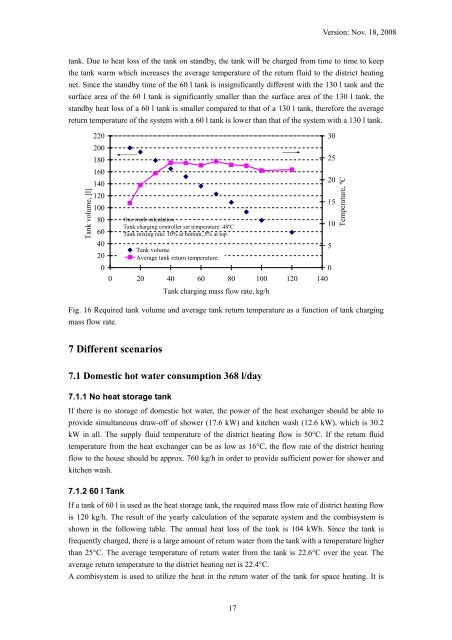Udvikling og demonstration af lavenergifjernvarme til lavenergibyggeri
Udvikling og demonstration af lavenergifjernvarme til lavenergibyggeri
Udvikling og demonstration af lavenergifjernvarme til lavenergibyggeri
You also want an ePaper? Increase the reach of your titles
YUMPU automatically turns print PDFs into web optimized ePapers that Google loves.
17<br />
Version: Nov. 18, 2008<br />
tank. Due to heat loss of the tank on standby, the tank will be charged from time to time to keep<br />
the tank warm which increases the average temperature of the return fluid to the district heating<br />
net. Since the standby time of the 60 l tank is insignificantly different with the 130 l tank and the<br />
surface area of the 60 l tank is significantly smaller than the surface area of the 130 l tank, the<br />
standby heat loss of a 60 l tank is smaller compared to that of a 130 l tank, therefore the average<br />
return temperature of the system with a 60 l tank is lower than that of the system with a 130 l tank.<br />
Tank volume, [l]<br />
220<br />
200<br />
180<br />
160<br />
140<br />
120<br />
100<br />
80<br />
60<br />
40<br />
20<br />
0<br />
One week calculation<br />
Tank charging controller set temperature: 48ºC<br />
Tank mixing rate: 10% at bottom, 5% at top<br />
Tank volume<br />
Average tank return temperature<br />
0 20 40 60 80 100 120 140<br />
Tank charging mass flow rate, kg/h<br />
Fig. 16 Required tank volume and average tank return temperature as a function of tank charging<br />
mass flow rate.<br />
7 Different scenarios<br />
7.1 Domestic hot water consumption 368 l/day<br />
7.1.1 No heat storage tank<br />
If there is no storage of domestic hot water, the power of the heat exchanger should be able to<br />
provide simultaneous draw-off of shower (17.6 kW) and kitchen wash (12.6 kW), which is 30.2<br />
kW in all. The supply fluid temperature of the district heating flow is 50°C. If the return fluid<br />
temperature from the heat exchanger can be as low as 16°C, the flow rate of the district heating<br />
flow to the house should be approx. 760 kg/h in order to provide sufficient power for shower and<br />
kitchen wash.<br />
7.1.2 60 l Tank<br />
If a tank of 60 l is used as the heat storage tank, the required mass flow rate of district heating flow<br />
is 120 kg/h. The result of the yearly calculation of the separate system and the combisystem is<br />
shown in the following table. The annual heat loss of the tank is 104 kWh. Since the tank is<br />
frequently charged, there is a large amount of return water from the tank with a temperature higher<br />
than 25°C. The average temperature of return water from the tank is 22.6°C over the year. The<br />
average return temperature to the district heating net is 22.4°C.<br />
A combisystem is used to u<strong>til</strong>ize the heat in the return water of the tank for space heating. It is<br />
30<br />
25<br />
20<br />
15<br />
10<br />
5<br />
0<br />
Temperature, ºC

















